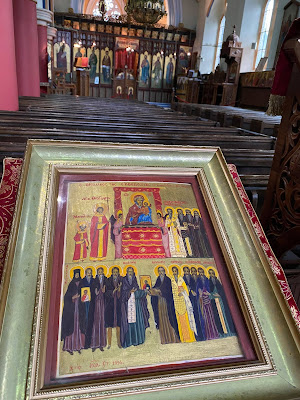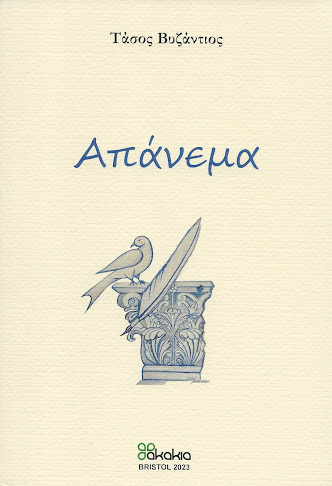On the 1st Sunday in Lent, the Sunday of Orthodoxy,
we organised in our Greek Orthodox Church of St. Peter and St. Paul in Bristol (UK) a Pan-Orthodox Vespers.
The two Priests of our Community (Fr. George and Fr. Anastasios) when joined by
Archimandrite Kyril Jenner and the Romanian Priest
Fr. Ioan Claudiu Moldovan, who were accompanied by members of their
congregations. The Service was also attended by the Honorary Romanian Consul to
Bristol Dr. Răzvan - Ungureanul Constantinescu.
At the end of the Service the President of our Community
Prof. Ioannis Ieropoulos welcomed everyone with warm words. Then the Ladies’
Sisterhood of our Community, chaired by Paulina Kofterou, offered delicious
refreshments to all people who attended the Pan-Orthodox Vespers.
Archimandrite Kyril Jenner offered a speech during the
Service. The actual speech is as follows:
Triumph
of Orthodoxy
On this, the first
Sunday of the Great Fast, the Orthodox Church celebrates the Triumph of
Orthodoxy over the iconoclasts. This event, in the year 843, marked the end of
the second period of iconoclasm, with the restoration of the holy icons in
churches and the proper veneration of those icons.
Iconoclasm
Iconoclasm went
through two phases. In the first there was considerable theological debate
about the use of icons. Much of that debate now often seems very obscure to us.
The concepts and language used around images reflects a conceptual
understanding that is very different from our contemporary understanding. What
came out of this debate is, however, enduring. We have the writings of such
Fathers of the Church as Saint John of Damascus and Saint Theodore the Studite.
The final expression of the teaching of the Church is given by the decrees of
the Seventh Ecumenical Council, the Second Council of Nicaea, held in 787.
This Council gave
formal expression to matters of terminology and practice in relation to icons.
It made clear the distinction between “veneration” and “adoration”, and also
why the icons may be venerated. This is what the Fathers of the Council stated:
We,
therefore, following the royal pathway and the divinely inspired authority of
our Holy Fathers and the traditions of the Catholic Church (for, as we all
know, the Holy Spirit dwells in her), define with all certitude and accuracy
that just as the figure of the precious and life-giving Cross, so also the
venerable and holy images, as well in painting and mosaic as of other suitable
materials, should be set forth in the holy churches of God, and on the sacred
vessels and on the vestments and on hangings and in pictures both in houses and
by the wayside, namely, the figure of our Lord God and Saviour Jesus Christ, of
our Most Pure Lady, the Mother of God, of the honourable Angels, of all Saints
and of all pious people. For by so much more frequently as they are seen in
artistic representation, by so much more readily are people lifted up to the
memory of their prototypes, and to a longing after them; and to these should be
given due salutation and honourable reverence (ἀσπασμὸν
καὶ
τιμητικὴν προσκύνησιν), not
indeed that true worship of faith (λατρείαν)
which pertains alone to the divine nature;
but to these, as to the figure of the precious and life-giving Cross and
to the Book of the Gospels and to the other holy objects, incense and lights
may be offered in accordance with ancient pious custom. For the honour which is
paid to the image passes on to that which the image represents, and he who
reveres the image reveres in it the subject represented. For thus the teaching
of our holy Fathers, that is the tradition of the Catholic Church, which from
one end of the earth to the other has received the Gospel, is strengthened. (Decree
of the Seventh Ecumenical Council:
https://ccel.org/ccel/schaff/npnf214/npnf214.xvi.xii.html)
Fullness
of faith
The Seventh
Ecumenical Council also endorsed the teachings of the previous Councils, so with
all the seven Councils together we have the statement of the fullness of our
Orthodox Faith. Sadly, the Seventh Ecumenical Coun
cil was followed shortly after by another period of iconoclasm. This period was marked by an absence of theological debate, being much more concerned with emotions and populism rather than with teaching. This is the period in which much whitewashing over the icons took place. There was some in the first period, but this was much more a characteristic of the second period.
cil was followed shortly after by another period of iconoclasm. This period was marked by an absence of theological debate, being much more concerned with emotions and populism rather than with teaching. This is the period in which much whitewashing over the icons took place. There was some in the first period, but this was much more a characteristic of the second period.
What
unites us
The restoration of
the use of icons was also a restoration of the fullness of Orthodox teaching,
and this is what unites us as Orthodox. As an Englishman who is a priest in the
Orthodox Church, I encounter two common questions.
The first is “Are
you Russian Orthodox or Greek Orthodox?” My initial answer to this is “Yes”.
Then I go on to explain that I am English (anyone who knows about surnames will
recognize that my family name indicates a Saxon origin - my mother's family
name also shows a family coming originally from one particular village in
Kent). I serve in a parish of historically Russian tradition under a Greek
Archbishop. We worship mainly in English. We might note that this year marks
150 years since regular services in English were first established. This was in
Wolverhampton, with a priest, Father Stephen Hatherley, who was born in Bristol
and later returned to Bristol, where his work died out, but from where he also
served in Cardiff, laying the foundations for the Greek community that is still
there. When I worked in Wolverhampton, I used to pass the site of his church
every day on my way to work. The church building had survived after the little
community there had closed down in 1874, but was de
molished around 100 years later to allow the enlargement of the car park of the neighbouring pub.
molished around 100 years later to allow the enlargement of the car park of the neighbouring pub.
The second
question I get is “What is the difference between Greek Orthodox and Russian
Orthodox?” My answer to that is “Language and music”. There is no difference in
doctrine. Differences in practice are minor and not important. Coming together
on this day is an affirmation of our fundamental unity.
Diverse
expressions
The differences
which we see today have arisen over many years. When Orthodoxy was confined to
the Middle East and Eastern Europe, these differences were of little
significance. People from different countries rarely moved, and so were not
affected by such differences.
Where there were
people speaking different languages in the same place it was possible to establish
separate churches in which they could worship. Saint John Chrysostom set an
example for this when he became Archbishop of Constantinople. When he arrived
in Constantinople, he found only a handful of Orthodox churches. Most of the
churches followed the Arian heresy, with a membership that was predominantly
from the Germanic Gothic-speaking community.
His approach to bringing these into the fullness of Orthodoxy was to set
up Orthodox churches where the services were in the Gothic language. These were
under his direct care as the local Bishop, and we know that he visited these
churches and preached in them. In this way, by using necessary diversity he
brought about a deeper unity.
In our time, when
people have moved to this country from all the countries where the Orthodox
Church was the local church, we have a problem. We present an appearance of
disunity. We are mostly classified along ethnic lines, according to the origin
of our local community. We have multiple Bishops exercising jurisdiction, in
clear contravention of Orthodox Canon Law, which only allows one Bishop in any
locality.
So, what can we do
at the local level? One thing is simply to get to know each other's
communities. In some ways this is easier for the laity than for the clergy, as
we are constrained to be in our own church every Sunday. We have to overcome
differences of language. It should not matter what language is used for the
Divine Liturgy - it is the same service in every language - but many find it
easier to pray when it is in a language with which they are familiar. But if we know the service well, we should
be able to pray wherever we are. I recall the story of a friend who attended
services at his local Polish Orthodox Church. These were only held twice a
month as the priest had two other small communities that he also served. On
Sundays when the Poles did not have a service this friend went to the local
Greek Orthodox Church. Different language and music, but much else looked very
similar. Particularly he noticed the little old ladies dressed in black and all
wearing headscarves. It was only after several weeks that he found that some of
these little old ladies were actually the same people. The Polish ladies simply
went to the Greek church to pray when they could not pray in their own church.
We have to work
from the bottom up. We have to recognize our fundamental unity and proclaim
that unity. We may remember the words
of the Russian theologian Khomiakov: “The Church is one. Her unity follows of
necessity from the unity of God; for the Church is not a multitude of persons
in their separate individuality, but a unity of the grace of God, living in a
multitude of rational creatures, submitting themselves willingly to grace.” (“The
Church is One”: https://pages.uoregon.edu/sshoemak/325/texts/Khomiakov/Khomiakov%20The%20Church%20is%20One.htm)
Let us pray that
we may demonstrate that unity in our service to the Church and in our witness
to God in our daily life.
















































No comments:
Post a Comment